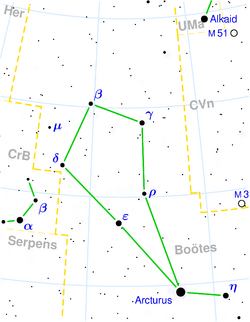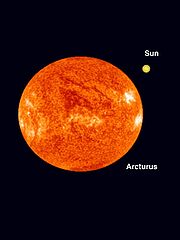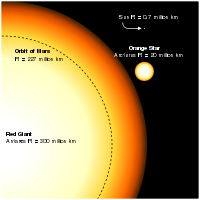Arcturus
 Arcturus in the constellation of Boötes. |
|
| Observation data Epoch J2000 Equinox J2000 |
|
|---|---|
| Constellation | Boötes |
| Pronunciation | /ɑrkˈtjʊərəs/ |
| Right ascension | 14h 15 m 39.7s |
| Declination | +19° 10' 56" |
| Apparent magnitude (V) | −0.04 |
| Characteristics | |
| Spectral type | K1.5IIIFe-0.5 |
| U−B color index | 1.27 |
| B−V color index | 1.23 |
| R−I color index | 0.65 |
| Variable type | Variable star |
| note (category: variability): | H and K emission vary. |
| Astrometry | |
| Radial velocity (Rv) | +5 km/s |
| Proper motion (μ) | RA: −1093.45 mas/yr Dec.: −1999.40 mas/yr |
| Parallax (π) | 88.98 ± 0.68 mas |
| Distance | 36.7 ± 0.3 ly (11.24 ± 0.09 pc) |
| Absolute magnitude (MV) | −0.29 |
| Details | |
| Radius | 25.7 ± 0.3[1] R☉ |
| Luminosity | 210 ± 10[2] L☉ |
| Temperature | 4,300[3] K |
| Metallicity | 20–50% Sun |
| Rotational velocity (v sin i) | <1.7 km/s |
| Other designations | |
| Database references | |
| SIMBAD | data |
| Data sources: | |
| Hipparcos Catalogue, CCDM (2002), Bright Star Catalogue (5th rev. ed.), VizieR catalog entry |
|
Arcturus (α Boo / α Boötis / Alpha Boötis) is the brightest star in the constellation Boötes. With a visual magnitude of −0.05, it is also the third brightest star in the night sky, after Sirius and Canopus. It is, however, fainter than the combined light of the two main components of Alpha Centauri, which are too close together for the eye to resolve as separate sources of light, making Arcturus appear to be the fourth brightest. It is the second brightest star visible from northern latitudes and the brightest star in the northern celestial hemisphere. The star is in the Local Interstellar Cloud.
An easy way to find Arcturus is to follow the arc of the handle of the Big Dipper. By continuing in this path, one can find Spica (α Virginis) as well—hence the maxim, "Arc to Arcturus, then speed on to Spica."
Contents |
Observational history
As one of the brightest stars in the sky, Arcturus has been significant to observers since antiquity. In Ancient Greece, the star's celestial activity was supposed to portend tempestuous weather. For citations, see Plautus Rudens prol. 71 and Lewis and Short's Latin Dictionary and its entry for Arcturus.
Prehistoric Polynesian navigators knew Arcturus as Hōkūleʻa, the "Star of Joy". Arcturus is the zenith star of the Hawaiian Islands. Using Hōkūleʻa and other stars, the Polynesians launched their double-hulled canoes from Tahiti and the Marquesas Islands. Traveling east and north they eventually crossed the equator and reached the latitude at which Arcturus would appear directly overhead in the summer night sky. Knowing they had arrived at the exact latitude of the island chain, they sailed due west on the trade winds to landfall. If Hōkūleʻa could be kept directly overhead, they landed on the southeastern shores of the Big Island of Hawaiʻi. For a return trip to Tahiti the navigators could use Sirius, the zenith star of that island. Since 1976, the Polynesian Voyaging Society's Hōkūle‘a has crossed the Pacific Ocean many times under navigators who have incorporated this wayfinding technique in their non-instrument navigation.
The Koori people of southeastern Australia knew Arcturus as Marpean-kurrk, and its appearance in the north signified the arrival of larvae of the wood-ant (a food item) in spring. The beginning of summer was marked by the star's setting with the sun in the west and the disappearance of the larvae. The star was also known as the mother of Djuit (Antares), and another star in Bootes, Weet-kurrk.[4]
Oscillations
As one of the brightest stars in the sky, Arcturus has been the subject of a number of studies in the emerging field of asteroseismology.
Belmonte et al. (1990) carried out a radial velocity (Doppler shift of spectral lines) study of the star in April and May 1988, which showed variability with a frequency of the order of a few microhertz, the highest peak corresponding to 4.3 μHz (2.7 days) with an amplitude of 60 ms−1, with a frequency separation of ~5 μHz. They suggested that the most plausible explanation for the variability of Arcuturus is stellar oscillations.
High precision photometry from the Hipparcos satellite's observations showed Arcturus is now known to be slightly variable, by about 0.04 magnitudes over 8.3 days. It is believed that the surface of the star oscillates slightly, a common feature of red giant stars. In the case of Arcturus, this was an interesting discovery as it is known that the redder (more towards or within the M spectral class) a giant gets, the more variable it will be. Extreme cases like Mira undergo large swings over hundreds of days; Arcturus is not very red and is a borderline case between variability and stability with its short period and tiny range.
System
Arcturus is a type K1.5 IIIpe orange giant star — the letters "pe" stand for "peculiar emission," which indicates that the spectrum of light given off by the star is unusual and full of emission lines. This is not too uncommon in red giants, but Arcturus has a particularly strong case of the phenomenon. It is at least 110 times visually more luminous than the Sun, but this underestimates its strength as much of the "light" it gives off is in the infrared; total power output is about 180 times that of the Sun. The lower output in visible light is due to a lower efficacy as the star has a lower surface temperature than the Sun.
Arcturus is notable for its high proper motion, larger than any first magnitude star in the stellar neighborhood other than α Centauri. It is moving rapidly (122 km/s) relative to the solar system, and is now almost at its closest point to the Sun. Closest approach will happen in about 4000 years, when the star will be a few hundredths of a light year closer to Earth than it is today. Arcturus is thought to be an old disk star, and appears to be moving with a group of 52 other such stars. Its mass is hard to exactly determine, but may be slightly larger than that of the Sun[5] (1.1-0.4+0.6 solar mass). Arcturus is likely to be considerably older than the Sun, and much like how the Sun will be in its red giant phase.
According to the Hipparcos satellite, Arcturus is 36.7 light years (11.3 parsecs) from Earth, relatively close in astronomical terms. Hipparcos also suggested that Arcturus is a binary star, with the companion about twenty times dimmer than the primary and orbiting close enough to be at the very limits of our current ability to make it out. Recent results remain inconclusive, but do support the marginal Hipparcos detection of a binary companion.[6]

Claims of a planetary system
In 1993, radial velocity measurements of Aldebaran, Arcturus and Pollux showed that Arcturus exhibited a long-period radial velocity oscillation, which could be interpreted as a substellar companion. This substellar object would be nearly 12 times the mass of Jupiter and be located roughly within Earth's orbital zone, at 1.1 Astronomical Units. However, all three stars surveyed showed similar oscillations yielding similar companion masses, and the authors concluded that the variation was likely to be intrinsic to the star rather than due to the gravitational effect of a companion. So far no substellar companion has been confirmed.[7]
Etymology and cultural significance
The name of the star derives from Ancient Greek Arktouros/Αρκτοῦρος, and means "Guardian of the Bear". This is a reference to it being the brightest star in the constellation Boötes (of which it forms the left foot), which is next to the Greater and Lesser Bears, Ursa Major and Ursa Minor.
In Arabic, it is one of two stars called al-simāk "the uplifted one", the other being Spica. Arcturus, then, is السماك الرامح as-simāk ar-rāmiħ "the uplifted one of the lancer". This has been variously romanized in the past, leading to obsolete variants such as Aramec and Azimech. The name Alramih is used in Geoffrey Chaucer's Treatise on the Astrolabe of 1391. Another Arabic name is Haris-el-sema, from حارس السماء ħāris al-samā’ "the keeper of heaven."[8][9][10]
In Chinese astronomy, Arcturus is called Da Jiao (大角, Great Horn, Pinyin: Dàjiǎo), because it is the brightest star in the Chinese constellation called Jiao Xiu (角宿, Pinyin: Jiǎo Xiǔ). And later, it become a part of Kang Xiu (亢宿, Pinyin: Kàng Xiǔ), which is also a Chinese constellation.
Ancient Japanese astronomy adopted the Chinese name Da Jiao (大角, Ro'ku too), but its western name, Arcturus (アルクトゥルス), is more common now.
In Inuit astronomy, Arcturus is called the Old Man.
It corresponds to the Hindu astronomy Nakshatra of Swati.

- 1933 World's Fair. The star achieved fame when its light was used to open the 1933 Chicago World's Fair. The star was chosen as it was thought that light from Arcturus had started its journey at about the time of the previous Chicago World's Fair in 1893. Technically the star is 36.7 light years away so the light would have started its journey in 1896.[11]
Myths
This bright star is the subject of numerous ancient and modern myths.
- Ancient Greece. In Greek mythology, Arcturus is a star created by Zeus to protect the nearby constellations Arcas and Callisto (Ursa major and Ursa minor). According to the myth, Callisto was the daughter of Lycaon, the king of Arcadia. As a young girl, she vowed to the goddess Artemis to be forever faithful and devoted to her. She was to remain a virgin forever in order to serve and accompany Artemis while hunting animals in the forest. However, one day, Zeus, the king of the gods, fell in love with Callisto and raped her. Callisto gave birth to a son whom she named Arcas. Zeus knew that if Hera, his wife, learned of his disloyalty she would be angry with Callisto, so in order to protect her he transformed her into a brown bear. Callisto, as a bear, roamed around the forest looking for her son. After years of searching she found Arcas, who was now a grown man. She finally came upon him and, overjoyed, stood on her hind legs and tried to embrace him. Arcas, however, did not recognize his mother and thought he was being attacked, so he drew his sword to defend himself. Zeus, watching everything, as usual, felt sorry for them and in order to prevent this tragedy he transformed Callisto and Arcas into constellations (now known as Ursa major and Ursa minor) and placed them near to him in the sky. Hera, who had learned the truth and was furious, asked Ocean, the river that surrounds the earth, not to permit them to wash themselves in his waters; therefore these two constellations are always seen high in the night sky, and never drop into the ocean. Moreover, in order to protect them from Hera's jealousy, Zeus placed another star near to them: Arcturus (which means the guardian of Arctos, the bear). It protects and accompanies them for eternity.
- Edgar Cayce. In a reading in which the 'sleeping prophet' describes philosophical concepts as they relate to religious tenets mentions Arcturus.
- (Q) The sixth problem concerns interplanetary and inter-system dwelling, between earthly lives. It was given through this source that the entity Edgar Cayce, after the experience as Uhjltd, went to the system of Arcturus, and then returned to earth. Does this indicate a usual or an unusual step in soul evolution?
- (A) As indicated, or as has been indicated in other sources besides this as respecting this very problem, - Arcturus is that which may be called the center of this universe, through which individuals pass and at which period there comes the choice of the individual as to whether it is to return to complete there - that is, in this planetary system, our sun, the earth sun and its planetary system - or to pass on to others. This was an unusual step, and yet a usual one. (5749-14)
- Occult traditions. In the astrology of the Middle Ages, Arcturus was one of the 15 Behenian fixed stars, associated with jasper and the plantain herb. Cornelius Agrippa lists its symbol
 under the alternate name Alchameth.
under the alternate name Alchameth.
- In Indian Astrology or Vedic Astrology or Sidereal Astrology, Arcturus is called 'Swati' which is a word derived from the language Sanskrit.
See also
- Arcturus in fiction
- Arcturus stream
References
- ↑ Angular diameters of stars from the Mark III optical interferometer., MOZURKEWICH D.; ARMSTRONG J.T.; HINDSLEY R.B.; QUIRRENBACH A.; HUMMEL C.A.; HUTTER D.J.; JOHNSTON K.J.; HAJIAN A.R.; ELIAS II N.M.; BUSCHER D.F.; SIMON R.S., Astron. J., 126, 2502-2520 (2003)
- ↑ Based upon the values for temperature and radius in combination with the Stefan–Boltzmann law.
- ↑ Oxygen abundances in halo giants. V. Giants in the fairly metal-rich globular cluster M 71., SNEDEN C.; KRAFT R.P.; LANGER G.E.; PROSSER C.F.; SHETRONE M.D, Astron. J., 107, 1773-1785 (1994)
- ↑ Mudrooroo (1994). Aboriginal mythology : an A-Z spanning the history of aboriginal mythology from the earliest legends to the present day. London: HarperCollins. p. 5. ISBN 1855383063.
- ↑ Ayres, T. R. & Johnson, H. R., ApJ, 1977, Vol 214, P410-417
- ↑ Verhoelst, T.; Bordé, P. J.; Perrin, G.; Decin, L.; Eriksson, K.; Ridgway, S. T.; Schuller, P. A.; Traub, W. A. et al. (2005). "Is Arcturus a well-understood K giant?". Astronomy & Astrophysics 435: 289. doi:10.1051/0004-6361:20042356, and see references therein.
- ↑ Hatzes, A., Cochran, W. (August, 1993). "Long-period radial velocity variations in three K giants". The Astrophysical Journal 413 (1): 339–348. doi:10.1086/173002. Bibcode: 1993ApJ...413..339H.
- ↑ List of the 25 brightest stars, website of the Jordanian Astronomical Society, accessed March 28, 2007.
- ↑ Richard Hinckley Allen, Star-names and their meanings (1936), p. 100-101.
- ↑ Hans Wehr (J.M. Cowan ed.), A dictionary of modern written Arabic (1994).
- ↑ "Century of Progress World's Fair, 1933-1934". University of Illinois-Chicago. 2008-01. http://collections.carli.illinois.edu/cdm4/item_viewer.php?CISOROOT=/uic_cop&CISOPTR=45&CISOBOX=1&REC=1. Retrieved 2009-09-06.
External links
Coordinates: ![]() 14h 15m 39.7s, +19° 10′ 56″
14h 15m 39.7s, +19° 10′ 56″
|
||||||||||||||||||||||||||||||||||||||||||||||||||||||||||||||||||||||||||||||||||||||||||||||||||||||||||||||||||||||||||||||||||||||||||||||||||||||||||||||||||||||||||||||||||||||||||||||||||||||||||||||||||||||||||||||||||||||||||||||||||||||||||||||||||
|
||||||||||||||